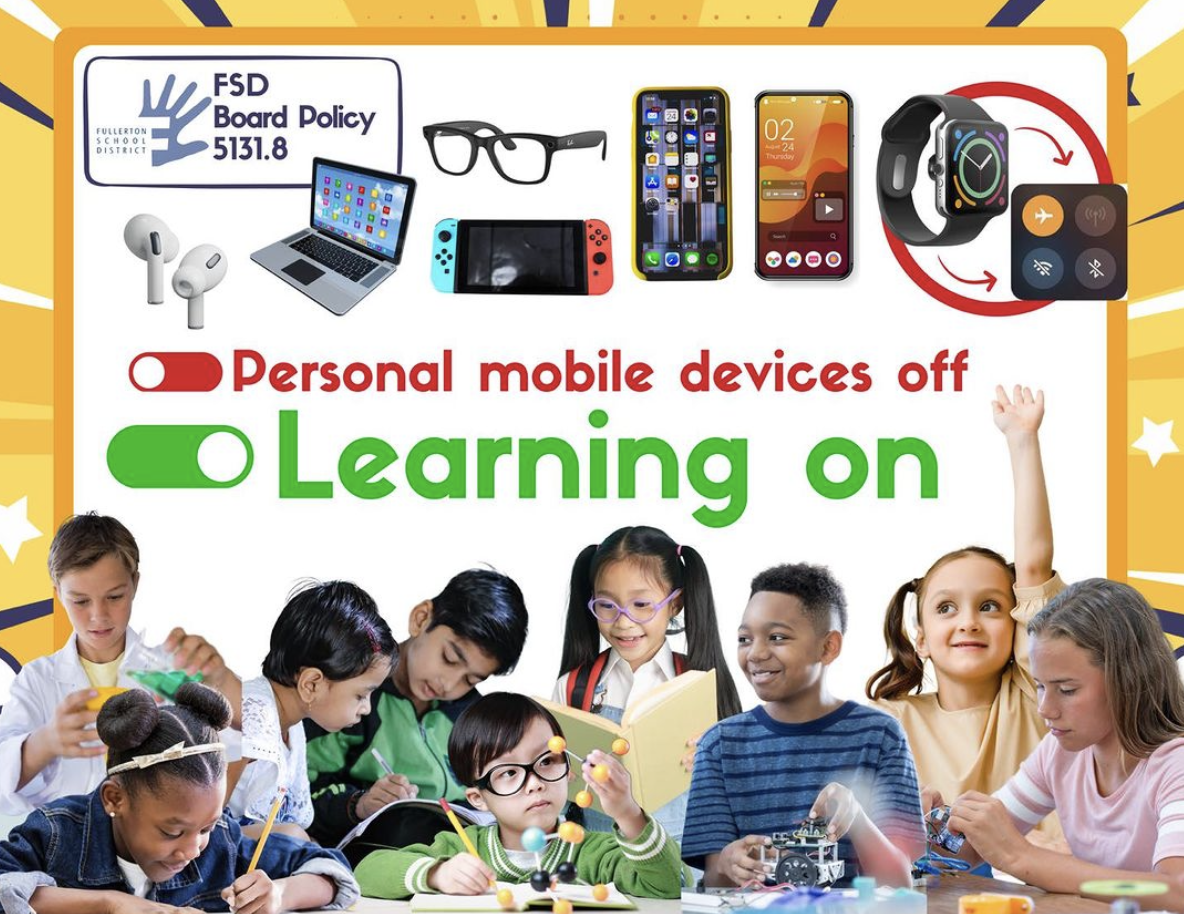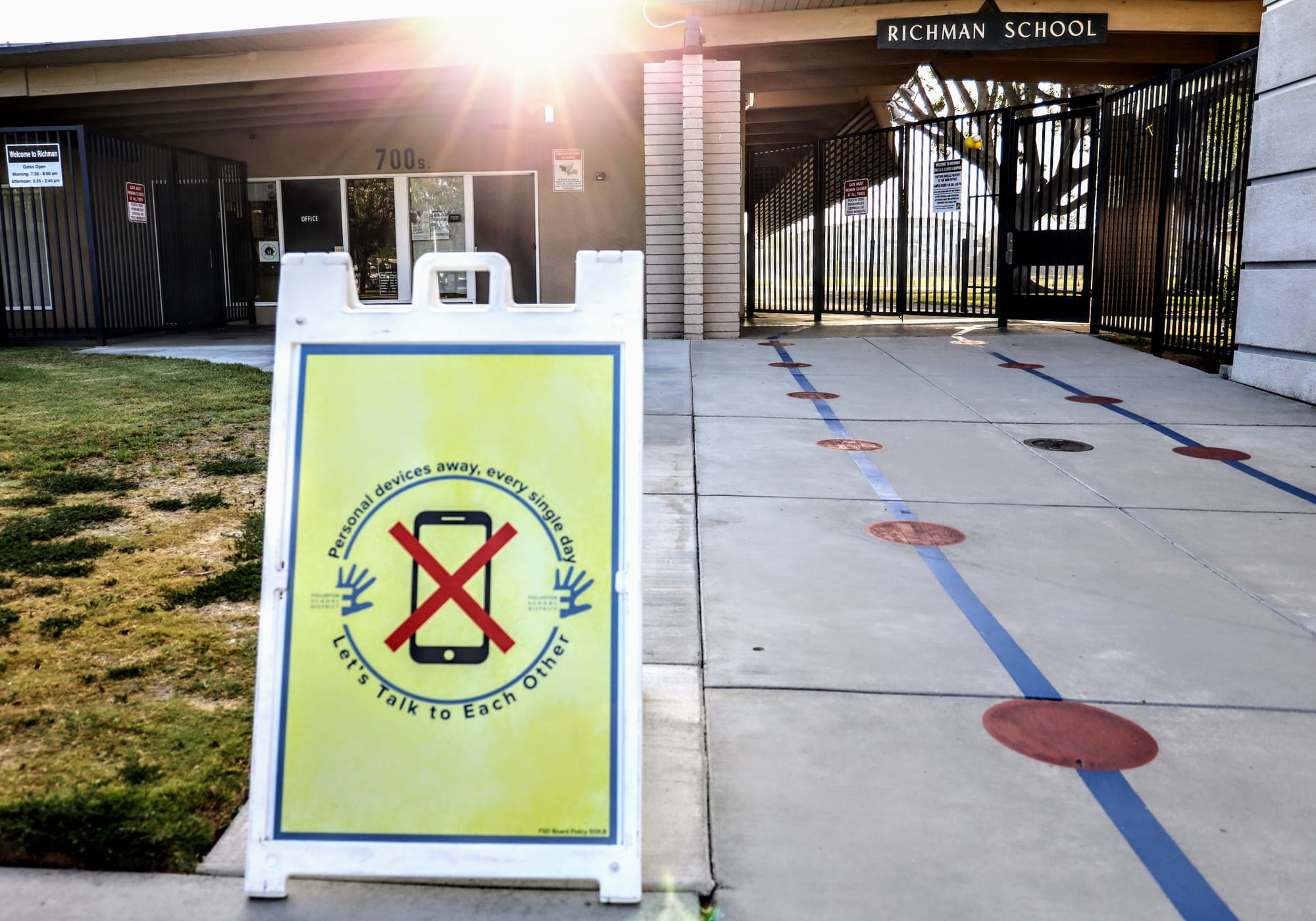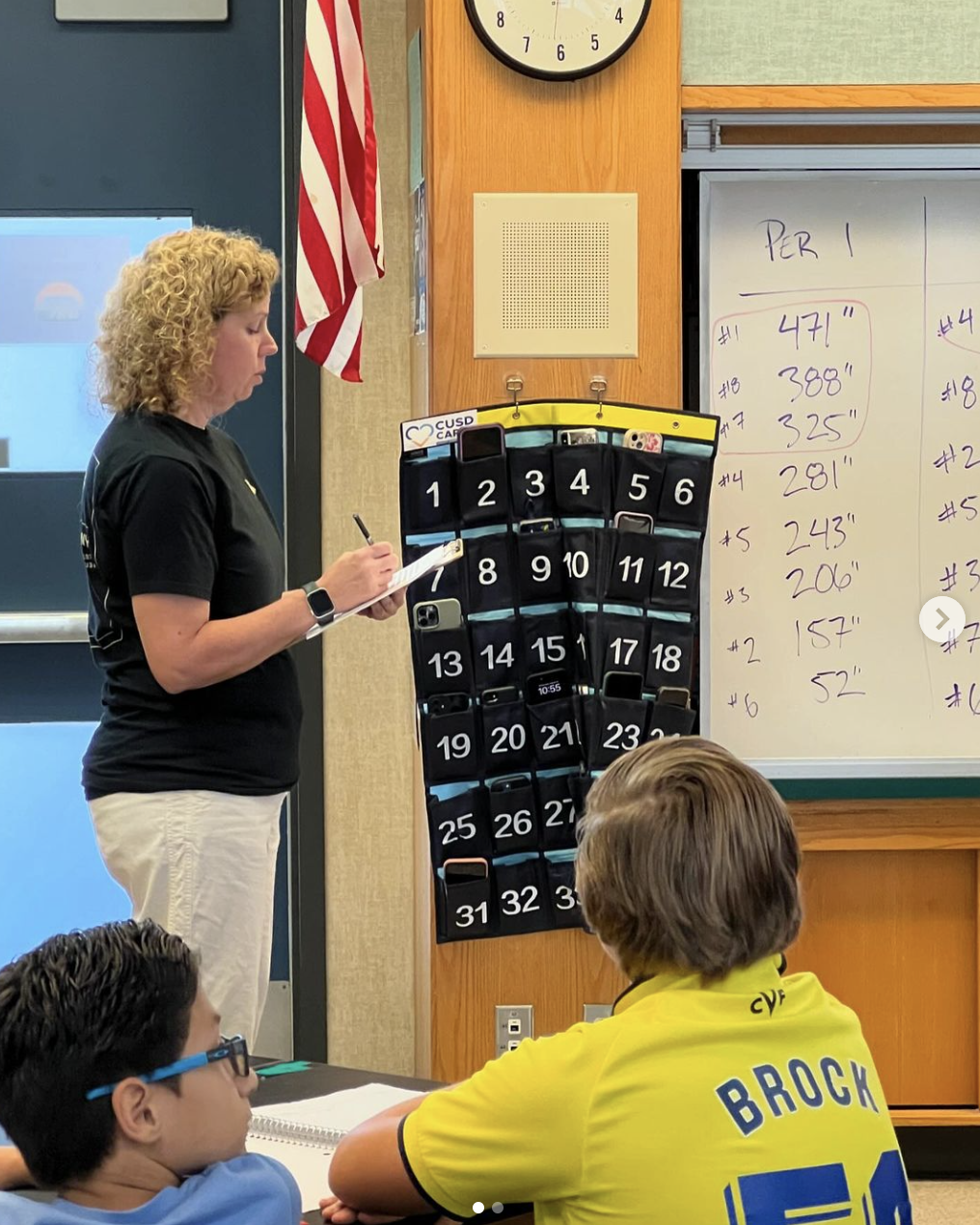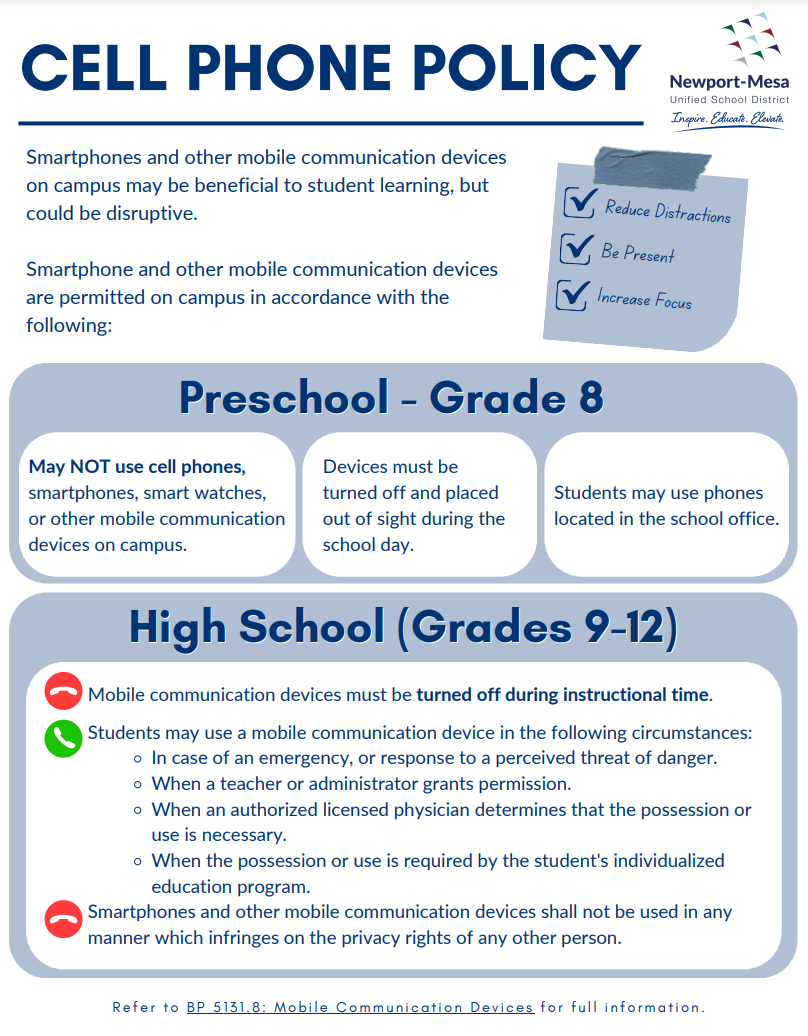O.C. Districts Curb Student Cellphone Use During School Day
California could soon require TK-12 public school districts to restrict students' cellphone use on campuses, but several local school boards are already taking action.

This back-to-school season could be remembered as a tipping point in how cellphones are used on TK-12 campuses in Orange County.
Over the summer, the Fullerton School District Board of Trustees passed a new policy that requires students to have their personal devices turned off, or placed in airplane mode, and put away for the entire school day.
Signs now greet students at every FSD campus with the message: “Personal devices away, every single day; Let’s talk to each other.”
The new policy, passed in a unanimous vote in July, impacts the entire K-8 district, which serves 11,400 students.
Schools locally, statewide, and nationwide, are enacting similar restrictions. In January, the National Center for Education Statistics found that 76% of public schools prohibit non-academic use of cellphones during the school day.
Educators are motivated, in part, by growing concerns and research showing cellphone use, and social media apps on phones, can negatively impact kids' mental health, academic performance, and development. (See coverage of Jonathan Haidt's book "The Anxious Generation" for a deeper dive.)
There are also worries that the devices are a distraction in the classroom, buzzing and dinging with alerts, and can also lead to cyberbullying.
On the other hand, many parents argue they have a right to reach their kids on a personal device during the school day due to safety concerns.
Others, including some students, say that bans are not the most effective way to deal with these issues and the emphasis should be on teaching students how to be responsible with their technology.
The FSD’s student cellphone policy aims to address more than one issue, according to Trustee Ruthi Hoffman Hanchett, a vocal supporter of the change and parent of two FSD students.
“I think we're teaching etiquette to kids,” Hanchett said in a phone interview, explaining that the policy is part of a districtwide effort to empower students to be responsible digital citizens.

The top goal of the policy is to minimize disruptions to learning and increase students’ focus on academics, Hanchett said. But it’s also intended to foster a campus culture that boosts student well-being through more screen-free interaction.
“We have a lot of evidence that [cellphones] are not good for our kids,” Hanchett said. “We have this opportunity and a responsibility to teach [students] how to use [cellphones] in a way that it’s a positive tool, but not something that distracts from their learning, and certainly not something that's going to be negative towards their self-image and their mental health,” she said.
Hanchett points out that there are exceptions to the FSD restrictions that are protected by law. Students can use devices if it is part of their Individualized Education Plan (IEP) or if they need it for a medical reason.
For example, a student with diabetes might use their cellphone to check their blood sugar level. And students can also use their devices in an emergency.
Students caught violating the policy could have their device taken away for the day by school administrators. Hanchett said each school site had flexibility on how it disciplines students.
Previously, FSD has had some instances of students using cellphones on campus to record video of fights, Hanchett shared, noting that it wasn’t a problem unique to FSD.
“The trauma of watching and knowing that that horrible situation is then being shared and posted and reshared by your peers – we can't underestimate how impactful that is and how harmful that is,” she said. Hanchett said that preventing future incidents was also a motivating factor for parents backing the new restrictions.
Other O.C. School Districts Enact Cellphone Policies
The FSD is one of a handful of local school districts making changes at the district level on this issue.
This school year, the Capistrano Unified School District, the largest in the county, is testing out new cellphone restrictions at all middle and high schools and four K-8 schools.
“We are piloting a cell phone program that teachers can use to limit distractions in the classroom,” Ryan K. Burris, spokesperson for the CUSD, wrote in an email to Spotlight Schools.
“Upon classroom entry, students would store their phones in a ‘pocket chart’ and retrieve them after class. The pilot is flexible so teachers have the option for no cellphones, or access to cellphones for an academic purpose.”
Las Flores Elementary in Rancho Santa Margarita is one of the K-8 campuses taking part in the program. A recent post on the school’s Instagram account showed the “pocket chart” being used in a science class. The caption reads: “Research shows that students who do not have access to phones are more engaged.”

Last October, The Newport-Mesa Unified School District updated its board policy to “create a more conducive learning environment that promotes academic focus and engagement and encourages positive social interactions among students.”
The new rules bar TK-8th graders from using cellphones and smartwatches on campus. Students can use phones located in the school office. Newport-Mesa USD high school students must have their devices turned off during instructional time, but they can be used in an emergency or with a teacher’s permission.
The Westminster School District is looking into developing a cellphone policy for its K-8 students. “There's a place for technology, but it should be regulated, and it should be part of the instructional design that the teacher has,” WSD Superintendent Gunn Marie Hansen, Ph.D., said in a recent interview.
She said the district and school board plan to partner with the community to put together a committee to look at the issue this year.

Student cellphone restrictions could soon be required at all of California’s public TK-12 schools. Last month, the California legislature passed the bipartisan Phone-Free Schools Act.
Likely to be signed into law by Governor Gavin Newsom, the act requires school districts to adopt a policy to limit or prohibit the use of cellphones by students at schools by July 1, 2026.
The policy would need to be developed with “significant stakeholder participation” to ensure it’s responsive to the needs of educators, parents, and students, according to the bill’s text. That approach is echoed in a recently published resource guide from the California Partners Project on how to draft cellphone policies in TK-12 schools.
Parents Urging Los Alamitos USD to Adopt Districtwide Cellphone Policy
Some parents in the Los Alamitos Unified School District are pushing to get a districtwide cellphone policy passed sooner rather than later.
A petition has been circulating online since August 14, urging leaders to act. It reads, in part: “We are deeply concerned about the detrimental impact of excessive social media use and cell phone access during school hours on our children’s mental health and academic well-being.”
District parent and pediatrician Lori Livingston, M.D., is helping organize the effort. In a phone interview last month, Dr. Livingston shared that she has seen an explosion in the number of mental health diagnoses, including anxiety and depression, among her patients over the last five years.
She described it as “overwhelming.”
She spent years trying to uncover the underlying cause, first questioning if it was due to children not getting enough sleep, or kids dealing with intense overscheduling in after-school activities, or an increased pressure to excel in school.
But once she read Haidt’s book, and did more research, she said she became convinced that increased screen time, and social media use in particular, is “the heart of the problem.”
“Our kids don’t even realize the damage this is doing to their own mental health and to other kids’ mental health. It’s not just fun and games and normal kid stuff,” Dr. Livingston wrote in a text message.
Dr. Livingston and other backers of the petition plan on speaking at the next Los Alamitos USD school board meeting scheduled for September 10.
At the board’s August 27 meeting, Superintendent Andrew Pulver, Ed.D., dedicated part of his report to respond to parents with diverse opinions who had reached out about the district’s cellphone policies over the summer.
“I've heard from different parents who have really advocated regarding the district banning cell phones on our campuses. And then I've heard from parents who said … This should be a parent decision and this is a parent right,” Dr. Pulver said.
Click on the video to hear Los Alamitos USD Superintendent Andrew Pulver, Ed.D., review the school-based cellphone policies at its nine campus during the August 27 Los Alamitos USD Board of Education meeting.
He then explained that the district has been restricting cellphone use by students at its six elementary schools, two middle schools, and Los Alamitos High School for many years. The policies, he said, can be found in each schools’ Parent/Student Handbook, and are basically similar in that devices are not allowed to be seen or heard during the school day on district campuses with TK-8th grade students.
At Los Alamitos High School, the rules are a little different. Students are permitted to use their phones during passing periods, nutrition, and lunch.
“Devices are expected to be turned off and out of sight while in class at the high school, … unless it's permitted by the teacher for academic use,” Dr. Pulver explained.
He said that some teachers choose to use pocket charts, known as “cellphone jail,” to store devices during class. Violating the policy four or more times could result in a student’s one-day suspension.
Dr. Livingston said she feels the existing school-based policies are ineffective.
“The current school rules in place are not working adequately,” she wrote in a text message this week. She shared that her 9th grader was recently sent a picture via Snapchat of her 7th grade brother from another student in his class during the school day. “This shouldn’t be happening. They are taking pictures of other kids and sharing them with other kids during class.”
A recent email newsletter sent to Oak Middle School families from Principal Evelyn Garcia seemed to reinforce the idea that the rules aren’t being followed.
“We have a growing concern with cellphone use on campus,” the message read. Parents were asked to help. “If you need to contact your child during the day, please call the school office, and we will relay your message promptly. This ensures that all communication is handled appropriately and without disruption to the learning environment. We ask for your full support in strictly enforcing this policy with your child at home,” part of the message stated.
In his report on August 27, Dr. Pulver agreed that to be effective, the cellphone policy has to be part of a multi-pronged effort that includes partnering with families.
“We're not handing out cellphones as a district to our students. They really are coming from the homes,” Dr. Pulver said. “So this has to also be something that parents and that guardians have to take an active role and make decisions on.”
He said the district has historically offered opportunities for parent education and would be hosting a parent workshop on September 12 with Project Reboot. The group says it has helped students reduce their screen time and develop healthy technology habits.
All 6th-12th grade students in the district will also participate in an assembly through Project Reboot during the school day, Dr. Pulver said.
“We understand that there is no one-size-fits-all solution, as this topic extends beyond the school environment and into the home,” Dr. Pulver said in an email to Spotlight Schools. “However, we remain dedicated to working closely with our families to find balanced and effective strategies that promote both the well-being and academic success of our students.”
Trustee Hanchett in the Fullerton School District, is promoting a similar approach noting that FSD offers online resources to parents.
“I really do believe we have to have grace, and learn as we go, but also empower parents and teachers and kids to have those healthy boundaries and … to learn how to be safe online,” Hanchett said.
“And sometimes that means limiting and denying access [to technology]. Sometimes it means modeling how to have good approaches. And then … as [students] grow and develop, giving them more freedom. But we have to be intentional about it, and that's what our goal as a district is.”
📱 We want to hear from you!
Please fill out this brief survey about cellphone use at TK-12 schools. Or email us at hello@spotlightschools.com. Your feedback may be used in an upcoming story.
Editor's Note: This story was updated to reflect the correct grade level of Dr. Livingston's son.
